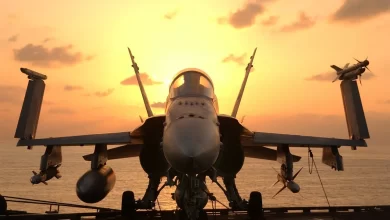Airbus A380 is a double-deck, wide-body airliner manufactured by the European aerospace company Airbus. It is the world’s largest passenger airliner. Its first flight was in 2005, and it has since become a popular choice for long-haul flights by many airlines around the world. The A380 is equipped with the latest in aviation technology and four massive engines. Its spacious cabin features a range of amenities, including in-flight entertainment systems, luxurious seating options, and ample space for passengers and their luggage. Despite its size, the A380 is designed to be environmentally friendly, with lower emissions and noise levels than many other large aircraft. The A380 has set new standards in commercial aviation, offering a comfortable and efficient way to travel long distances.
- The A380 is the world’s largest commercial passenger airliner, with a wingspan of 80 meters (262 feet) and a length of 73 meters (239 feet).
- The Airbus Masterpiece is capable of flying up to 8,000 nautical miles (14,800 kilometres) on a single tank of fuel. This allows it to fly nonstop between some of the world’s busiest airports.
- The A380 is capable of carrying up to 323,000 litres (85,300 gallons) of fuel, making it one of the most fuel-efficient aircraft in its class.
- The A380 is equipped with four Rolls-Royce Trent 900 or Engine Alliance GP7200 turbofan engines, each capable of producing up to 80,000 pounds of thrust. They are among the most powerful commercial jet engines ever produced.
- The aeroplane can accommodate up to 853 passengers in a high-density configuration or 525 passengers in a typical three-class configuration.
- The A380 has 50% more floor space than the Boeing 747, and its cabin is designed to offer passengers more comfort and space, with wider seats and aisles and larger overhead storage bins.
- The Airbus Masterpiece has a range of advanced features, including fly-by-wire flight controls, a glass cockpit, and advanced avionics and computer systems. The A380’s cockpit features state-of-the-art avionics systems, including six large LCDs.
- The A380 has a top speed of Mach 0.89 (about 680 miles per hour or 1,100 kilometres per hour).
- The eroplane has a maximum takeoff weight of 1.2 million pounds (560,000 kilograms), which is equivalent to the weight of approximately 100 elephants—making it one of the heaviest aircraft in the world.
- The Airbus A380 aeroplane has won numerous awards for its design and performance, including the prestigious Collier Trophy in 2007.
- Despite its size, the A380 is designed to be environmentally friendly, with lower fuel consumption and emissions than many other large aircraft.
- The A380 has a total of 16 passenger doors, including eight on the main deck and eight on the upper deck, to allow for efficient boarding and disembarking.
- The A380 has a wingspan that is wider than its overall length, making it the only commercial airliner in history with such a design.
- The aeroplane has a maximum cruising altitude of 43,000 feet (13,100 meters), which is higher than most other commercial aircraft.
- The A380 has a unique staircase located at the rear of the aircraft, which allows for easy access between the upper and lower decks.
- The Airbus Masterpiece has a total of 22 wheels, with four main landing gear assemblies and two nose gear assemblies. The wheels are arranged in a 4-6-12 configuration.
- The A380 has a wingspan that is so wide that it required modifications to many airports, including the construction of new taxiways and runways, in order to accommodate the aircraft.
- The aeroplane has a total of 530 kilometres (329 miles) of wiring, which is more than twice the amount found in the Boeing 787 Dreamliner.
- The A380 has a cockpit that is equipped with advanced flight management systems, including an electronic flight bag, which allows pilots to access important flight information and maps.
- The Airbus Aeroplane has been used by many airlines around the world, including Emirates, Singapore Airlines, Qantas, and Lufthansa.
- The eroplane has a cargo capacity of up to 170 cubic meters (6,000 cubic feet), allowing it to carry large amounts of freight in addition to passengers.
- The A380’s wings are so large that they had to be transported by barge and road from Airbus’ manufacturing site in Broughton, Wales, to its final assembly plant in Toulouse, France.
- The Airbus A380 has a total of 16 fuel tanks, which can hold up to 320,000 litres (84,500 gallons) of fuel.
- The A380 has a total of 22,000 light-emitting diodes (LEDs) installed in its cabin, providing mood lighting that can be adjusted to create a more comfortable and relaxing atmosphere for passengers.
- The A380’s engines are so powerful that they can lift the aircraft off the ground while carrying a weight equivalent to 560 fully-grown elephants.
- The Airbus A380 aeroplane has a maximum cruising speed of approximately 560 miles per hour (900 kilometres per hour), making it one of the fastest commercial airliners in operation.
- The A380’s cockpit is equipped with a range of advanced systems, including a heads-up display (HUD) that allows pilots to view important flight information without looking down at their instruments.
- The A380’s cabin is equipped with advanced air conditioning and air filtration systems that can completely change the air in the cabin every three minutes, helping to prevent the spread of germs and viruses.
- The A380’s horizontal stabilizer (tail fin) is the largest ever fitted to a passenger aircraft, with a surface area of approximately 845 square feet (78.5 square meters).
- The A380’s wings feature advanced technology that allows them to flex and twist slightly during flight, helping to reduce stress on the wings and improve fuel efficiency.
- The A380’s cockpit is equipped with an enhanced vision system (EVS), which uses infrared cameras to provide pilots with a clear view of the runway during takeoff and landing, even in low visibility conditions.
- The A380’s cabin features advanced lighting systems that can simulate natural light patterns, helping to reduce jet lag and improve passenger comfort.
- The Airbus A380 has a total of 12,000 sensors installed throughout the aircraft, which monitor everything from engine performance to cabin pressure and temperature.
- The A380 has a total of 4.5 million individual parts, including more than 100,000 electrical cables and 40,000 fasteners.
- The aeroplane’s cockpit is located on an upper deck, providing pilots with an excellent view of the runway during takeoff and landing.
- The A380’s windows are 15% larger than those on other commercial aircraft, providing passengers with a better view of the outside world.
- The A380’s cabin is equipped with advanced in-flight entertainment systems, including individual seat-back screens and audio/video on demand.
- The Airbus masterpiece A380 air-frame is made up of approximately 60% advanced lightweight materials, such as carbon fiber composites and titanium alloys.
- The A380 has a total cargo capacity of up to 60 tons, allowing it to transport a wide range of goods in addition to passengers.
- The A380’s wings are designed to flex up to 5 meters (16 feet) during flight, allowing them to withstand heavy turbulence and gusts.
- The aeroplanes’s engine noise levels are up to 50% lower than those of older, less advanced aircraft, making it one of the quietest commercial airliners in operation.
- The A380’s 500 km/h (310 mph) cruise speed is faster than most other commercial airliners.
- The Airbus A380’s wingtips are equipped with small vertical fins called winglets, which help to reduce drag and improve fuel efficiency.
- The A380’s onboard kitchens are among the largest and most advanced in the industry, allowing airlines to prepare and serve high-quality meals to passengers.
- The A380’s flight deck is equipped with advanced weather radar systems, allowing pilots to detect and avoid severe weather conditions.






